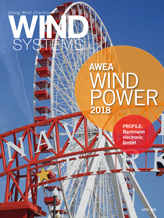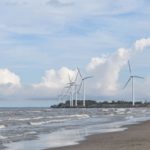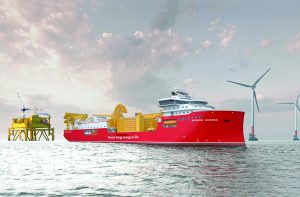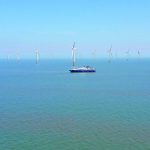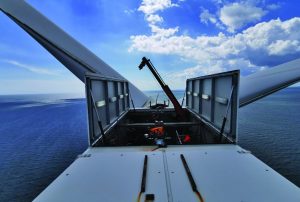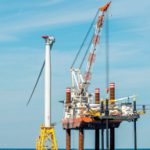American wind energy continues to power forward to reach new heights. Today, it powers more U.S. families and businesses than ever before — the country now has enough installed wind capacity to power more than 28 million American homes. That means wind has become a key contributor to our electricity mix, and the days of wind occupying a niche space are long gone.
Wind continues to expand to new areas, as 41 states now have utility-scale wind farms. Last year, wind surpassed conventional hydropower, and it is now the country’s largest source of renewable energy capacity. It likely will not be long before wind surpasses hydropower in terms of generation as well. Utilities and Fortune 500 companies continue to buy ever increasing amounts of wind to meet their electricity needs, and that means more jobs and more opportunities for Americans in all 50 states.
What further developments can we expect to see in the years to come?
Cheaper wind means more wind
In each of the last three years, wind power has been one of the top three sources of new U.S. electric generating capacity. For this to happen, wind needs to win on cost, and in fact, wind is now the cheapest source of new electric generating capacity in many parts of the country. It’s also cost-competitive in many more. Overall, wind’s costs are down by two-thirds since 2009.
Several factors have made such dramatic declines possible. Technological advances help modern turbines access stronger, steadier winds. That means new projects can generate more electricity more of the time. It also expands the map of existing wind projects. In 2017, North Carolina’s first utility-scale wind farm came online. This project would not have been possible without the advances of the past several years. Ground has also broken at Arkansas’s first wind farm, and projects are under development in Virginia as well, meaning wind will continue its expansion into new frontiers.
%%0418-AWEA-1%%
Improved domestic manufacturing has also played a key role in driving wind’s cost down. Today, more than 500 U.S. factories build many of the 8,000 parts in a typical wind turbine. Given the scale of certain wind components, transportation costs are lowered as more companies choose to locate new factories in the U.S. rather than importing from overseas. That has the added bonus of creating new opportunities for factory towns badly in need of them.
Recent wind deals demonstrate just how low these developments have driven wind’s cost. Investment firm Lazard Inc. reported late last year that, “in some scenarios, the full-lifecycle costs of building and operating renewable-based projects have dropped below the operating costs alone of conventional generation technologies such as coal and nuclear. This is expected to lead to ongoing and significant deployment of alternative energy capacity.”
Recent results from Xcel Energy’s request for proposals (RFP) for new power in Colorado show how cost-competitive wind has become. Companies submitted more than 400 bids for new power projects, and wind energy led all technologies with the lowest median bid price: $18.10 per megawatt hour, a truly remarkable milestone. Nor was this result a one-off outlier — more than 100 wind projects were proposed, signifying these rock bottom prices are indicative of broad industry trends.
In reviewing these results, Vox energy and climate reporter Dave Roberts concluded, “Let’s face it: In most areas of life, when you look past the hype at the real numbers, it’s depressing. Renewable energy is one area where that typical dynamic is diverted. The closer you look, the better the news gets … It is the cheapest power available in more and more places, and by the time children born today enter college, it is likely to be the cheapest everywhere. That’s a different world.”
“These prices should have every policymaker, utility, and energy investor in the region reconsidering their thinking about how much renewable energy to purchase, and when,” wrote Kevin Steinberger and Noah Long of the Natural Resources Defense Council. “The short answer: as much as you can get, and now.”
The wind-belt leads the way
Texas continued to be America’s wind-power leader in 2017 with more new wind projects becoming operational than any other state. In fact, Texas has more than three times the installed wind capacity as second place Oklahoma. The Sooner State is no slouch, however, as it passed Iowa to claim second place in installed capacity last year. California and Kansas round out the top five, proving wind is popular in both red and blue states.
The wind development pipeline continues to be robust, too. More than 28,600 MW of new wind projects are under construction or in the advanced stages of development, a 34 percent year-over-year increase. That is enough new wind to power millions of additional American homes. Thirty percent of this activity is in the Midwest, 21 percent in Plains states, 20 percent in the Mountain West, and another 20 percent in Texas. This anticipated market growth, combined with existing capacity, positions wind to supply 10 percent of America’s electricity by 2020, a visionary goal laid out in the Department of Energy’s Wind Vision report.
Customers remain hungry for more wind power
Utilities, Fortune 500 companies, and other buyers all inked substantial wind deals in 2017 — overall power purchase agreements (PPAs) were up 29 percent from 2016. And the deal flow has not slowed. In just the first two months of 2018, more than 2,300 MW of new deals have been struck.
Fortune 500 companies continued the trend of powering more of their operations using wind. From Nike to Anheuser-Busch to Amazon and General Mills, businesses across the economic spectrum turned to wind in 2017. Significantly, Google achieved its 100 percent renewable energy goal in 2017, and wind supplied 95 percent of that electricity. On the municipal side, San Francisco’s Bay Area Rapid Transit System inked a wind PPA that will supply a substantial portion of its energy.
%%0418-AWEA-2%%
These buyers turn to wind for two reasons: because its costs are both low and they are fixed. Because the fuel cost of wind never changes, buyers know exactly what they will pay for electricity five, 10, or 15 years down the road — an attractive property that facilitates long-term planning.
“Our approach takes different business, social, and environmental benefits into account,” Anheuser-Busch InBev said when announcing its 100 percent renewable target. “We do not expect our cost base to increase. Renewable electricity is competitive with or cheaper than traditional forms of electricity in many markets.”
“Establishing a 100 percent renewable energy goal helps us better serve society by reducing environmental impact,” said GM Chairman and CEO Mary Barra. “This pursuit of renewable energy benefits our customers and communities through cleaner air while strengthening our business through lower and more stable energy costs.”
Demand for wind means American jobs
All of this new wind means jobs for American workers. They build turbines, construct wind farms, and keep projects running through skilled operations and maintenance. In fact, there are now more than 100,000 wind jobs across all 50 states. And wind-turbine technician, along with solar installer, is one of America’s two fastest growing jobs, according to the U.S. Bureau of Labor Statistics.
“It just seems like this is the future. This is where we are headed, and where we should be headed,” said Meredith Halfpenny, who has helped build about 400 wind turbines and climbed uptower an estimated 1,200 times. “Working in renewables, you feel good about it. A lot of people are drawn to it, and it resonates with people. Everyone comes together very quickly. You have a collective purpose for your jobs.”
Once again, Texas is the country’s job leader, followed by Iowa, Oklahoma, and Colorado. A recent report on Texas wind workers found:
“(They) include veterans and women, those leaning politically right and left, environmentalists and climate-change skeptics, the civically engaged and those who never vote. The clean energy component seems to be a bonus for some, but it was not the primary reason they chose this field. There is the laid-off gas worker who noticed all the wind turbines on the horizon and thought there must be an opportunity there. The English major who couldn’t find a job and remembered how much she liked the outdoor work on her family’s farm in the Texas panhandle. The two veterans who liked the element of risk and heights and the sweet spot of job independence and camaraderie.”
Bringing opportunities to farming towns
More than 99 percent of wind farms are built in rural areas — places that often need new investment. Wind farms frequently become the largest taxpayers in a county, so these communities get substantial new revenues to fill out town budgets. That can help pay teacher salaries, fund fire departments, and fix roads while keeping local taxes low.
Sheldon, New York, for example, eliminated local taxes completely for eight years because wind revenue met its budgetary needs. In Van Wert County, Ohio, wind made it possible for the Lincolnview school district to provide every student in grades K through 12 with their own computer and fund the repair and replacement program.
%%0418-AWEA-3%%
“In pre-wind, our county taxable value was $500 million,” said Ken Becker, executive director of the Sweetwater Economic Development Corp. in Texas. “In 2008 (after wind came to the area), it was $2.8 billion.”
More than 98 percent of wind farms are also built on private land, and in exchange, landowners receive lease payments hosting turbines. This is guaranteed income that helps during the hard times, especially important in a thin margin business like agriculture. For many families, it makes the difference between continuing a multi-generation tradition and ending a way of life.
“Financially, it’s a huge boost to us,” says third generation Colorado farmer Richard Wilson. “And I know if we didn’t have this wind farm, my sons wouldn’t be able to keep this. I might have been able to, but they could not — there’s no question.”
Tapping into a new ocean energy resource
U.S. land-based wind has been growing since the 1980s, and to date, there are nearly 54,000 wind turbines spread across 41 states. But it wasn’t until last year that five offshore turbines made their way to U.S. shores with the completion of the Block Island Wind Farm.
Now, 14 offshore projects are under development in U.S. waters, with particularly active areas along the coasts of Long Island, Maryland, and Massachusetts. And companies are investing R&D money to cut offshore costs further, including $35 million in a South Carolina facility to test a 9.5-MW offshore wind turbine.
That continued development will create new supply chains and jobs in coastal cities up and down our seaboards.
The outlook for American wind power remains bright — we’re adding new chapters to this American success story, and the good news should continue for years to come.
















